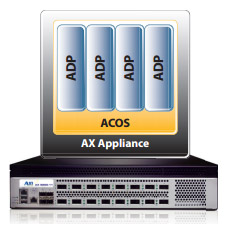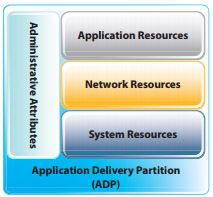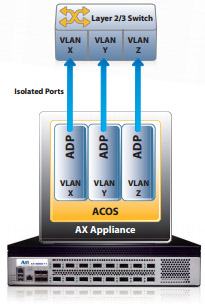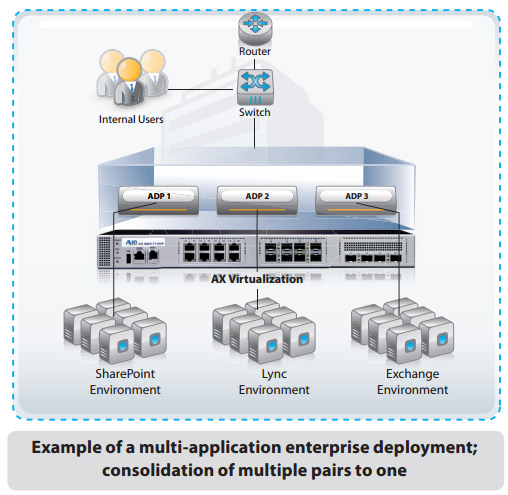
Application Delivery Partitions (ADPs): Multi-tenant Application Delivery Controller Virtualization
Multi-tenancy for Efficient Data Center Growth
Ever increasing traffic demands have resulted in the proliferation of Application Delivery Controllers (ADCs) and advanced server load balancers; this highlights the need for more efficient deployment options. A10's Application Delivery Partitions (ADPs) are a proven virtualization solution within its AX Series ADCs, fulfilling the key requirements of high density and high performance. The ADP virtualization technology provides separation and partitioning of multiple ADCs on a single AX Series platform, helping organizations to dramatically reduce total cost of ownership (TCO) without sacrificing performance or ease of use.
Data Center Consolidation, Scalability and Efficiency
Rack density, performance (no hypervisor layer) and the lowest cost per ADC instance are the strongest differentiating factors for A10's ADPs versus other multi-tenant architectures. Rack density is essential to virtualization return on investment; however, this can only be effiective if the newly deployed ADC system can deliver the same performance as the system it is targeted to replace. A single AX Series appliance can deliver over 100 partitions, expanding to over 1000 in an AX Virtual Chassis System (aVCS) cluster. As A10's ADPs do not use a hypervisor, native AX Series performance is divided according to the required number of partitions, without 3rd party software impact. Benefits of A10's ADPs include:
- Highest rack density of any multi-tenant ADC
- Lowest cost per ADC instance
- Reduced CAPEX for new ADCs
- Consolidation of legacy ADCs
- Simplified management for lower OPEX
- Highest performance multi-tenancy
 What Makes Up an ADP?
What Makes Up an ADP?
ADPs are made up of discrete computing elements designed to efficiently segment each ADC partition, isolated in secure partitions. Built upon A10's scalable Advanced Core Operating System (ACOS), each ADP has:
- Administrative Resources
- Granular access with role-based access control
- Includes users, privileges, and so on
- System Resources
- Consumable resources allocated per partition
- Includes number of concurrent sessions for each partition, and Layer 4 connections per second (CPS) per partition
- Network Resources
- Network interfaces, VLANs, IP addresses, dynamic routing, and so on
- Includes separate Layer 3 networking resources defined per partition
 Application Resources
Application Resources
- Real servers, virtual servers, templates, and so on
- Includes separate application Virtual IP addresses (VIPs) and Layer 7 aFleX TCL scripting rules for deep packet inspection and traffic adjustment
ADP Partitions and Layer 3 Virtualization
Of particular interest in ADPs is Layer 3 Virtualization (L3V). L3V allows organizations to use the same IP address ranges (for example, overlapping RFC 1918 ranges) to ensure the multi-tenant data center architecture has the same flexibility as a separately deployed device.
In simple terms, this allows each ADP to have the same IP addresses defined, if the administrator so chooses.

Customer Success Stories: Reducing TCO and Improving Internal Efficiency with ADPs
ADPs are applicable for any type of organization to drive operational efficiency, and potentially a lot more. Two customer use cases include:
- Subaru – consolidated enterprise environment resulting in lower TCO:
- Internal applications (such as Microsoft Exchange) and external web properties are serviced in a combined single ADC deployment, simplifying administration and removing the need to purchase a second pair of ADCs. Separate isolated operational environments are maintained between the internal and external zones.
- Peak Hosting – reduced TCO and differentiated Hosting/Cloud Services for competitive advantage:
- Customers moving to the cloud require advanced ADC features and more control. ADPs enable Peak to offer full ADC functionality and management to customers. ADPs reduce Peak's costs as an ADC does not need to be bought for each customer. The customer can have full control, improving satisfaction and reducing the need for Peak's staff to assist with frequent routine operations.

Summary
A10's ADPs within the AX Series platforms deliver a straightforward, clear solution for higher density and higher performance multi-tenant ADCs:
- High performance multi-tenancy for applications and organizations
- No virtualization (hypervisor) performance penalty
- Reduces the number of ADC units required
- Cost-effective production quality multi-tenancy
- L3V eases transition to multi-tenant confi gurations
- Reduced management complexity
- Integrated natively into ACOS; no third-party software or licenses
ADPs can be used by any size organization for public or private cloud enablement. In addition to ADPs, A10 offers additional flexible ADC virtualization choices, including aVCS for scalability, SoftAX for flexibility, aCloud for cloud solutions and AX-V for strong isolation.

